Related Research Articles

Beadwork is the art or craft of attaching beads to one another by stringing them onto a thread or thin wire with a sewing or beading needle or sewing them to cloth. Beads are produced in a diverse range of materials, shapes, and sizes, and vary by the kind of art produced. Most often, beadwork is a form of personal adornment, but it also commonly makes up other artworks.

Bead stringing is the putting of beads on string.

A shackle, also known as a gyve, is a U-shaped piece of metal secured with a clevis pin or bolt across the opening, or a hinged metal loop secured with a quick-release locking pin mechanism. The term also applies to handcuffs and other similarly conceived restraint devices that function in a similar manner. Shackles are the primary connecting link in all manner of rigging systems, from boats and ships to industrial crane rigging, as they allow different rigging subsets to be connected or disconnected quickly. A shackle is also the similarly shaped piece of metal used with a locking mechanism in padlocks. A carabiner is a type of shackle used in mountaineering.

An earring is a piece of jewelry attached to the ear via a piercing in the earlobe or another external part of the ear. Earrings have been worn by people in different civilizations and historic periods, often with cultural significance.

A rope is a group of yarns, plies, fibres, or strands that are twisted or braided together into a larger and stronger form. Ropes have tensile strength and so can be used for dragging and lifting. Rope is thicker and stronger than similarly constructed cord, string, and twine.

Seed beads or rocailles are uniformly shaped, spheroidal beads ranging in size from under a millimeter to several millimeters. Seed bead is also a generic term for any small bead. Usually rounded in shape, seed beads are most commonly used for loom and off-loom bead weaving. They may be used for simple stringing, or as spacers between other beads in jewelry.

Macramé is a form of textile produced using knotting techniques.
Body piercing jewelry is jewelry manufactured specifically for use in body piercing. The jewelry involved in the art of body piercing comes in a wide variety of shapes and sizes in order to best fit the pierced site. Jewelry may be worn for fashion, cultural tradition, religious beliefs, personal symbolism, and many other reasons.
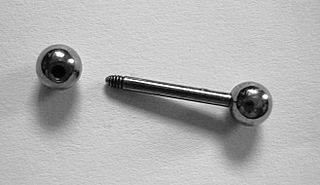
Barbell style piercing jewelry is composed of a straight bar with a bead on each end, one or both beads unscrewable for removal and/or changing of the beads. Often one of the beads is fixed, either via epoxy or welding, so that only one bead is used to install or remove the jewelry. Barbell threads are usually right-handed.

Filigree is a form of intricate metalwork used in jewellery and other small forms of metalwork.

In metalworking, crimping is a method of joining two or more pieces of metal or other ductile material by deforming one or both of them to hold the other. The bend or deformity is called the crimp.
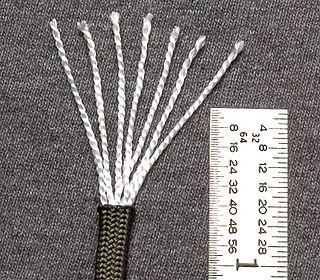
Parachute cord is a lightweight nylon kernmantle rope originally used in the suspension lines of parachutes. This cord is now used as a general purpose utility cord. This versatile cord was used by astronauts during the 82nd Space Shuttle mission to repair the Hubble Space Telescope.
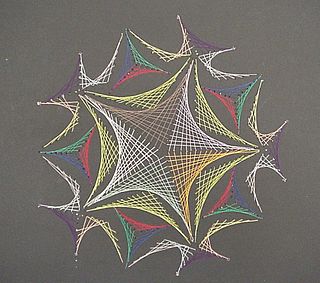
String art or pin and thread art, is characterized by an arrangement of colored thread strung between points to form geometric patterns or representational designs such as a ship's sails, sometimes with other artist material comprising the remainder of the work. Thread, wire, or string is wound around a grid of nails hammered into a velvet-covered wooden board. Though straight lines are formed by the string, the slightly different angles and metric positions at which strings intersect gives the appearance of Bézier curves. Quadratic Bézier curve are obtained from strings based on two intersecting segments. Other forms of string art include Spirelli, which is used for cardmaking and scrapbooking, and curve stitching, in which string is stitched through holes.
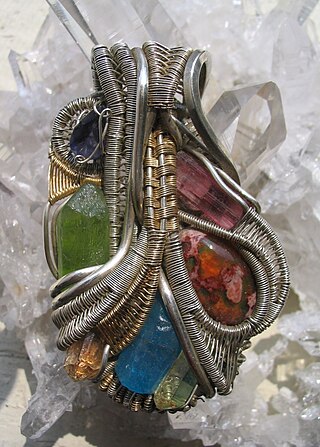
Wire wrapping is one of the oldest techniques for making handmade jewelry. This technique is done with jewelry wire and findings similar to wire to make components. Wire components are then connected to one another using mechanical techniques with no soldering or heating of the wire. Frequently, in this approach, a wire is bent into a loop or other decorative shape and then the wire is wrapped around itself to finish the wire component. This makes the loop or decorative shape permanent. The technique of wrapping wire around itself gives this craft its name of wire wrapping.

Novelty yarns include a wide variety of yarns made with unusual features, structure or fiber composition such as slubs, inclusions, metallic or synthetic fibers, laddering and varying thickness introduced during production. Some linens, wools to be woven into tweed, and the uneven filaments of some types of silk are allowed to retain their normal irregularities, producing the characteristic uneven surface of the finished fabric. Man-made fibres, which can be modified during production, are especially adaptable for special effects such as crimping and texturizing.

Goldwork is the art of embroidery using metal threads. It is particularly prized for the way light plays on it. The term "goldwork" is used even when the threads are imitation gold, silver, or copper. The metal wires used to make the threads have never been entirely gold; they have always been gold-coated silver or cheaper metals, and even then the "gold" often contains a very low percent of real gold. Most metal threads are available in silver and sometimes copper as well as gold; some are available in colors as well.
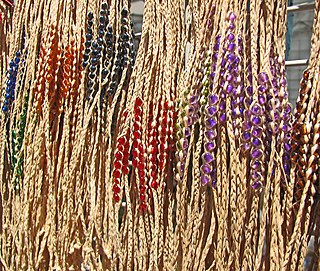
Hemp jewelry uses hemp twine material which is made from the Cannabis sativa plant, otherwise known as “Common Hemp”, which is cultivated to make goods such as food, fuel, clothing and textiles, cosmetics, paints, paper, building materials, and plastics, among others. Some types of hemp jewelry include bracelets, necklaces, anklets, rings, watches, masks, purses, and other adornments. The jewelry can also make use of other materials, such as glass, wood, bones, rocks, or gems.
Anni Schaad founded the German jewelry making company langani.

String is a long flexible structure made from fibers twisted together into a single strand, or from multiple such strands which are in turn twisted together. String is used to tie, bind, or hang other objects. It is also used as a material to make things, such as textiles, and in arts and crafts. String is a simple tool, and its use by humans is known to have been developed tens of thousands of years ago. In Mesoamerica, for example, string was invented some 20,000 to 30,000 years ago, and was made by twisting plant fibers together. String may also be a component in other tools, and in devices as diverse as weapons, musical instruments, and toys.

Waist beads are a type of jewelry worn around the waist or hip area. Originating in Africa, they are traditionally worn by women as a symbol of waist size, beauty, sexuality, femininity, fertility, well-being, and maturity.
References
- ↑ Pam Scheunemann (2010). Cool Beaded Jewelry. ABDO Publishing Company. p. 15. ISBN 1617846317.
- ↑ Amanda Doughty (2009). Bangles and Bracelets. A & C Black. p. 42. ISBN 0713679298.
- ↑ Elizabeth Gourley; Ellen Talbott (2002). Quick & Easy Beaded Jewelry. Krause Publications. p. 11. ISBN 087349377X.
- ↑ Deborah Schneebeli-Morrell (2004). Vintage-Style Beaded Jewelry. North Light Books. p. 8. ISBN 1581805470.
- ↑ Lockwood (1988), p. 86.
- ↑ Lockwood (1988), p. 87.
- ↑ Cheryl Owen (2007). 101 Sparkling Necklaces. Random House. p. 14. ISBN 1770074783.
- ↑ Dawn Cusick; Megan Kirb (2003). The Michaels Book of Arts & Crafts . Sterling Publishing. p. 498. ISBN 1579905307.
- ↑ Sara Withers; Stephanie Burnham (2005). The Encyclopedia of Beading Techniques: A Step-by-Step Visual Guide, with an Inspirational Gallery of Finished Works. Running Press. p. 16. ISBN 076242043X.
- ↑ Irene From Petersen (2005). Silver Wire Jewelry: Projects to Coil, Braid & Knit. Sterling Publishing. p. 8. ISBN 1579906451.
- ↑ John Michael Greer; Clare Vaughn (2007). Pagan Prayer Beads: Magic and Meditation with Pagan Rosaries. Red Wheel/Weiser/Conari. p. 56. ISBN 1578633842.
